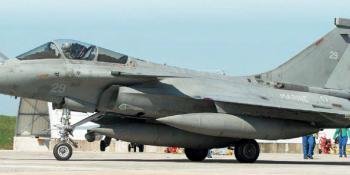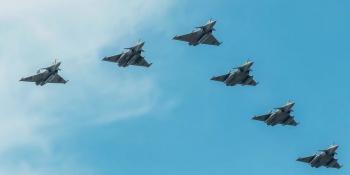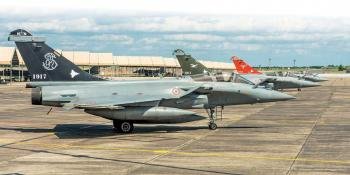FRANCE


ON OCTOBER 31, the Direction Générale de l’Armement (Directorate-General for Armaments) announced the Rafale F3-R standard had met the requirements originally set in 2014 and was approved for service release.
The F3-R standard features two main upgrades compared to the F3 standard currently in service. The first is the new MBDA Meteor active radarguided beyond-visual-range air-to-air missile, which in combination with the Thales RBE2 active electronically scanned array (AESA) radar, will allow the Rafale to engage aerial targets approximately 100km (62 miles) away. According to a report by the French National Assembly’s Committee on National Defence and Armed Forces dated October 12, MBDA is expected to deliver 69 Meteor missiles in 2018 and 31 in 2019; a follow-up order for another 60 is expected next year.
The second is the TALIOS designator pod produced by Thales; its name the acronym for TArgeting Long-range Identification Optronic System. Four TALIOS pods were delivered in 2018 and divided between the Armée de l’Air and Aéronautique Navale or Aéronavale. Another ten are expected in 2019, and by 2025 45 TALIOS pods are expected to be in service.
In its October report, the National Assembly’s Committee on National Defence and Armed Forces questioned if 45 pods will be enough for the French Armed Forces. In the first semester of this year, only 54% of designator pods within the French Armed Forces were serviceable.
Although the age of the fleets of ATLIS, PDL-CTS and DAMOCLES pods is part of the issue, the committee pointed out that the harsh environments of Opération Barkhane and Opération Chammal, as well as the intense use of the pods, are also big contributing factors to the fleet’s low availability.
Committee members therefore think the number of new pods might not suffice to carry out operational missions in such environments while at the same time facilitating aircrew training back in France.
Other upgrades included in the F3-R standard are updates to the SPECTRA integrated electronic warfare suite; the name is an acronym for Self-Protection Equipment to Counter Threats for Rafale Aircraft.
France has a current fleet of 144 Rafale fighters. According to the Direction Générale de l’Armement, the first ten airframes (a mix of Armée de l’Air and Aéronavale aircraft) are currently undergoing upgrade to F3-R standard, with the first four due to be delivered before the end of 2018.
Already in development, F4 is the next major upgrade standard for the Rafale. Announced by the then French Minister of Defence, Jean-Yves Le Drian, on March 20, 2017, the first F4 elements should be introduced from 2023 onwards and the first complete F4 standard aircraft should join an operational squadron in 2025.
Meanwhile, production of Rafale for international customers continues. The first aircraft destined for the Indian Air Force, serial number RB 008, made its first flight on October 30. The Egyptian Air Force has received more of its aircraft; three (DM07, DM08, DM10) were ferried to Egypt on September 25, followed by another three (probably DM09, DM11,
DM12) on October 30.
New sticks
On November 6, the Direction Générale de l’Armement announced it had ordered 567 MICA NG (New Generation) air-to-air missiles from MBDA and that the company will upgrade the propulsion system of 300 MICAs currently in the French Armed Forces arsenal. The MICA beyond visual range air-to-air missile has a range of approximately 50km (31 miles), and has been in service for over two decades.
The MICA NG variant features an improved infrared seeker and can communicate with the Rafale’s AESA radar, which offers smarter detection capability. Being laden with fewer electronic components means the NG variant can carry more fuel, yielding an extended range.
A new feature on the NG variant is the addition of internal sensors to enable personnel to check easily the status of the missile. As with the Rafale aircraft, personnel will carry out maintenance based on input from the sensors instead of conducting fixed maintenance cycles, often when no maintenance is required.
The MICA NG will be compatible with Rafale F3-R and F4 standard. Upgrades to existing MICA EM (Electromagnetics) and MICA IR (Infrareds) will allow the Rafales, Mirage 2000-5s and upgraded Mirage 2000Ds to continue operating with the missile until 2030-timeframe.
Maritime patrol modernisation
The Direction Générale de l’Armement was busy in early November. Not only did it announce the news on the MICA NG missile, but it also issued a report that Dassault Aviation will start the next phase of a study into the replacement of the Aéronavale’s eight Falcon 50M and five Falcon 200 Guardians.
A programme, called AVSIMAR (from Avion de Surveillance et d’Intervention Maritime) is likely to be based on the Falcon 2000 LXS executive jet.
A one-year study will determine what changes need to be made to the new aircraft and which systems will be needed in order to retain mission efficiency in the many tasks the current Falcon and Guardian aircraft conduct on a regular basis.
The first three AVSIMAR aircraft should be delivered by 2025.





